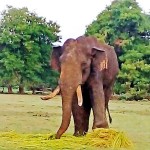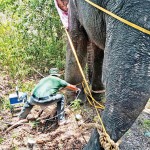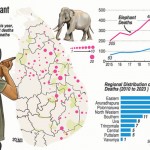News
Hundreds more elephants are being killed
View(s):By Kasun Warakapitiya
Elephant deaths have gradually increased over the years as the human-elephant conflict remains unresolved, a senior wildlife official said.
The Department of Wildlife Conservation (DWC) statistics show that for the eight months this year there have been 305 elephant deaths. Since 2015 — that recorded 205 elephant deaths– there has been a gradual increase in the numbers.
Last year, 439 elephants died islandwide.
DWC Director General Chandana Sooriyabandra told the Sunday Times that tuskers and elephants are getting shot while they are also being electrocuted due to illegally laid electrical wiring.
- A treat for Agbo: Villagers had brought fresh vegetables last week to feed the elephant and below; Agbo’s wounds being attended to
Apart from that, elephants are also getting killed due to hakkapatas, an improvised explosive that contains gunpowder, lead, and iron and is balled up into the shape of a firecracker. It is used to illegally kill wild game.
Elephant-related issues have aggravated due to the drought as well as elephants move in search of water and food, Mr. Sooriyabandra said.
Farmers have started to grow crops throughout the year due to advancements in irrigation systems; therefore, the farmland that was periodically released to the wild has also been lost, he pointed out.
“In Galgamuwa, farmers who were earlier cultivating one season are now cultivating both seasons, depriving the elephants of the land that they could feed on during the drought,’’ he said.
Mr. Sooriyabandra said the DWC lacks human resources too to carry out conservation activities and take action against people who commit wildlife-related crimes.
He added that they had notified the Salary and Cadre Commission that the department required 3,000 staff for wildlife, but the Ministry of Public Services had not yet approved it due to the current economic crisis.
The Sunday Times learned that there are only 685 wildlife officers, and one officer has to be responsible for over 1,688 hectares.
A senior wildlife officer who requested anonymity told the Sunday Times that impractical ministerial decisions, pressures from politicians and businessmen, encroachment on elephant home ranges, and an increase in human activities caused human-elephant issues to remain unresolved.
He said businessmen seek land, while politicians who make promises of land try to build settlements in elephant-frequented areas in their electorates to gain votes.
The official said that they were dumbfounded by the idea of cutting trenches in wildlife borders to keep elephants away from villages as it was an impractical task, yet it too was carried out under the instructions of politcians.
An environmentalist said that the relocation of elephants, the use of electric fences, and elephant drives have not been proper solutions.
Supun Lahiru Prakash, convener of the Biodiversity Conservation Research Circle, said the Wildlife Department has not used scientifically proven methods to find a solution to the human-elephant conflict.
He said repeated elephant translocations and fencing have failed. The DWC has to take a scientific approach.
“If the National Action Plan for Mitigating Human Elephant Conflict in Sri Lanka—December 2020—is wholly implemented by appointing a presidential task force, solutions for the conflict can be found,” he said.
The National Action Plan has given long-term and short-term actions to be followed by the DWC and other governmental stakeholders as well as the people to mitigate the issue, yet it remains to be implemented, he said.
Dr. Tharaka Prasad, the director in charge of wildlife health, said that of late, they have observed a rise in the number of elephants being shot.
During the drought, more elephants are being shot and electrocuted by illegally installed electrical wiring.
Meanwhile, treatment for the wounded tusker, Agbo, is continuing, three months after he was shot at.
Agbo is the victim of a trap gun. The DWC has sent documentation to the Foreign Ministry to bring down a team of foreign veterinary surgeons to carry out further treatment.
Dr. Pasad said the people are voicing concerns about “Gajaba”, another tusker that is limping. The tusker has a stiffened elbow joint and has a gait similar to Muthu Raja (Sak Surin), who was flown back to Thailand for treatment. Currently, we have no plans to treat Gajaba,’’ Dr. Prasad said.
“Agbo too will limp and walk after recovery; his fate too will be similar after the bones heal and become stiffened. Apart from that, another tusker named “Chandi” too has been shot, and we are planning to treat him as well.’’
Chandi was relocated many times and returned to its home range despite all odds. Recently, the tusker was scheduled to be translocated by the DWC once more, but that attempt was temporarily halted due to public outcry.
The best way to say that you found the home of your dreams is by finding it on Hitad.lk. We have listings for apartments for sale or rent in Sri Lanka, no matter what locale you're looking for! Whether you live in Colombo, Galle, Kandy, Matara, Jaffna and more - we've got them all!




